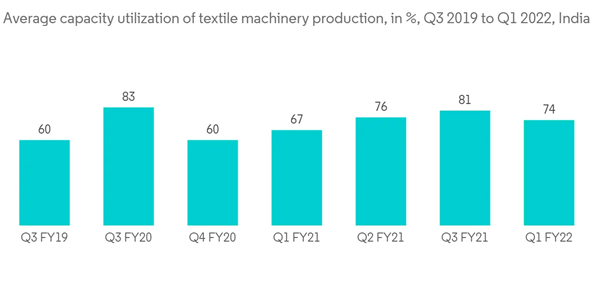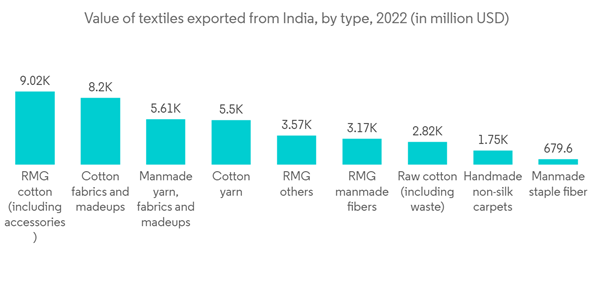The Global Textile Machinery Market size is estimated at USD 31.67 billion in 2024, and is expected to reach USD 40.18 billion by 2029, growing at a CAGR of 4.87% during the forecast period (2024-2029).
Asia-Pacific is close to most of the countries that make clothes and textiles. This gives producers a huge chance to meet demand in the region.In order to lower operating costs, automation is in great demand in countries where production costs are high and labor is expensive. During the projected period, factors such as automation and rising demand are expected to provide a substantial potential for manufacturers to meet the need for technologically upgraded cotton spinning machines.
The Indian textile machinery industry is experiencing tremendous growth, facilitated by the country's booming textile and apparel markets. Cotton production in India is expected to reach 7.2 million metric tons (43 million bales of 170 kg each) by 2030, owing to rising consumer demand. Currently, the textile machinery industry plays an increasingly vital role in shifting India's textile and apparel industry from labor-intensive production to a more advanced and industrialized sector. With the growing demand for textile machinery in both domestic and international markets, the Indian textile machinery industry is expected to see greater development in the near future.
From April 2016 to March 2021, Japan, Mauritius, Italy, and Belgium were the top FDI providers to India's textile sector (including dyed and printed textiles).. India achieved its highest-ever Textiles and Apparel (T&A) and Handicrafts export total of USD 44.4 billion in FY 2021-22, representing a 41% and 26% rise over equivalent amounts in FY 2020-21 and FY 2019-20, respectively. From 2017 to 2022, FDI invested USD 1522.23 million in the textile sector.
Because of schemes like the Pradhan Mantri Mega Integrated Textile Region and Apparel (PM MITRA) Parks, the Production Linked Incentive (PLI) Scheme for Textiles, and the allocation of Rs. 1480 crore (USD 180.84 million) for the National Technical Textiles Mission (NTTM), FDI may increase in the Indian textile industry in the future.
Some of the leading players in the textile machinery market around the world are OC Oerlikon, Trützschler Group Benninger AG (Jakob Müller AG), Savio Macchine Tessili S.p.A., Camozzi Group SpA., Itema SpA., and Lakshmi Machine Works Limited, among others.
This product will be delivered within 2 business days.
Key Highlights
- The increased need for sophisticated equipment that generates high-quality fabric as well as advancements in printing technology in textile production are driving market expansion. The increased use of automation and robots in textile manufacturing is also boosting the textile machinery industry.
- Machine makers now provide complex machines with increased production capacity and speed, as well as textile machinery, at cheap costs. Several small-scale market participants also help to make the machinery sector more competitive, and multinational firms have entered the global market, raising competition and forcing enterprises to improve their innovation and productivity. Because of constant technical improvements, the textile machinery industry is particularly dynamic, shifting from traditional to more complex solutions.
- While the COVID-19 situation brought problems such as shortages of raw materials, price increases, and disruptions in the supply chain, the pent-up demand during this period resulted in an increase and recovery in orders in 2021. The important and major changes created by the pandemic in daily life have also brought concepts such as sustainability, circular production, and digitalization into the focus of stakeholders investments and decisions. The world's leading textile machinery and technology manufacturers anticipate that the increasing momentum and sustainable production-oriented developments that began in 2022 will continue in 2023 and that the sector will revive with the organization of numerous international exhibitions.
Textile Machinery Market Trends
Spinning Machine Segment is the Fastest Growing Machinery Segment
The spinning machinery segment is expected to be the fastest-growing textile machinery segment over the next five years. Much of this segment's growth can be attributed to the expansion of the cotton spinning machinery. The cotton spinning machine market is likely to be driven by rising demand for textile goods and environmentally friendly fibers in emerging countries. Europe is a significant producer of textile machines.Asia-Pacific is close to most of the countries that make clothes and textiles. This gives producers a huge chance to meet demand in the region.In order to lower operating costs, automation is in great demand in countries where production costs are high and labor is expensive. During the projected period, factors such as automation and rising demand are expected to provide a substantial potential for manufacturers to meet the need for technologically upgraded cotton spinning machines.
The Indian textile machinery industry is experiencing tremendous growth, facilitated by the country's booming textile and apparel markets. Cotton production in India is expected to reach 7.2 million metric tons (43 million bales of 170 kg each) by 2030, owing to rising consumer demand. Currently, the textile machinery industry plays an increasingly vital role in shifting India's textile and apparel industry from labor-intensive production to a more advanced and industrialized sector. With the growing demand for textile machinery in both domestic and international markets, the Indian textile machinery industry is expected to see greater development in the near future.
Asia-Pacific region is the Fastest Growing Region
The Asia-Pacific region is expected to dominate the global textile machinery industry. The rising involvement of foreign firms in the garment and textile sectors is an important element driving regional market expansion. Asia Pacific's major textile machine markets include India, Vietnam, China, Japan, South Korea, and Indonesia. The presence of a significant textile sector and rising garment demand are driving regional growth. Furthermore, growing investments by global firms in the textile sector in India are fueling regional growth.From April 2016 to March 2021, Japan, Mauritius, Italy, and Belgium were the top FDI providers to India's textile sector (including dyed and printed textiles).. India achieved its highest-ever Textiles and Apparel (T&A) and Handicrafts export total of USD 44.4 billion in FY 2021-22, representing a 41% and 26% rise over equivalent amounts in FY 2020-21 and FY 2019-20, respectively. From 2017 to 2022, FDI invested USD 1522.23 million in the textile sector.
Because of schemes like the Pradhan Mantri Mega Integrated Textile Region and Apparel (PM MITRA) Parks, the Production Linked Incentive (PLI) Scheme for Textiles, and the allocation of Rs. 1480 crore (USD 180.84 million) for the National Technical Textiles Mission (NTTM), FDI may increase in the Indian textile industry in the future.
Textile Machinery Industry Overview
The companies in the global textile machinery industry don't have a lot of market share because the market is very competitive and divided.There are a lot of mergers and acquisitions going on right now because companies want to grow their geographic reach and their own knowledge. For example, in October 2021, Kornit, a company that was an early leader in digital printing machines, bought Voxel8, a company that made new textile additive manufacturing technology. The technique developed by Voxel8 enables the digital manufacture of functional features with zonal control of material characteristics as well as the use of high-performance elastomers adhering to inkjet technology.Some of the leading players in the textile machinery market around the world are OC Oerlikon, Trützschler Group Benninger AG (Jakob Müller AG), Savio Macchine Tessili S.p.A., Camozzi Group SpA., Itema SpA., and Lakshmi Machine Works Limited, among others.
Additional Benefits:
- The market estimate (ME) sheet in Excel format
- 3 months of analyst support
This product will be delivered within 2 business days.
Table of Contents
1 INTRODUCTION
4 MARKET INSIGHTS AND DYNAMICS
5 MARKET SEGMENTATION
6 COMPETITIVE LANDSCAPE
Companies Mentioned (Partial List)
A selection of companies mentioned in this report includes, but is not limited to:
- ATE Pvt Ltd
- Benninger AG (Jakob Muller AG)
- Camozzi Group S.p.A.
- Itema S.p.A.
- Lakshmi Machine Works Ltd
- Murata Machinery Ltd.
- OC Oerlikon Management AG
- Rieter
- Santex
- Rimar Group
- Santoni S.p.A.
- Saurer Intelligent Technlogy AG
- TMT Machinery Inc.
- Toyota Industries Corporation
- Trutzschler Group SE
Methodology

LOADING...










